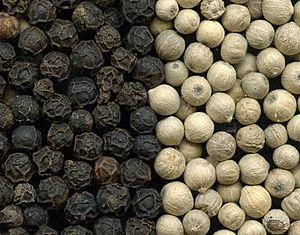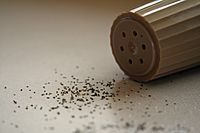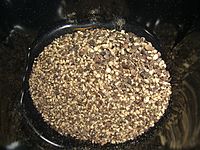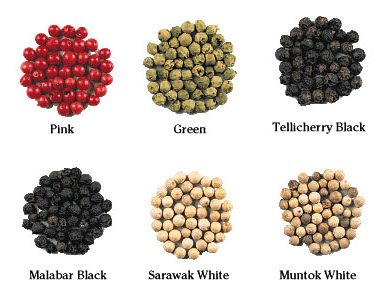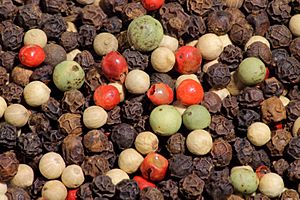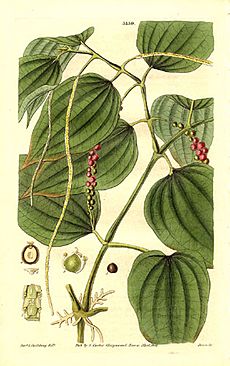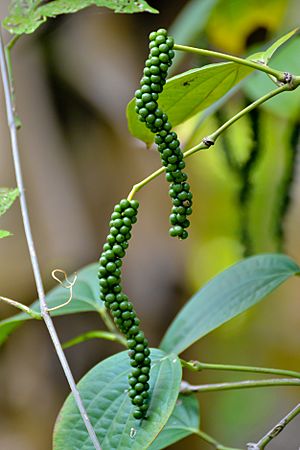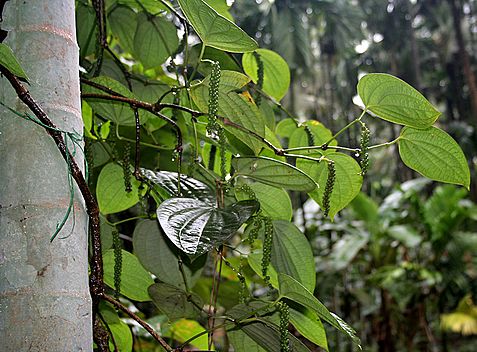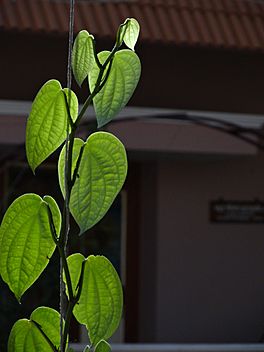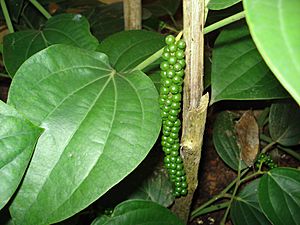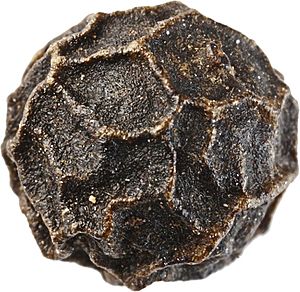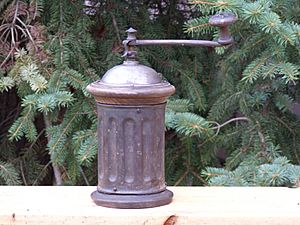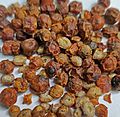Black pepper facts for kids
Quick facts for kids Black pepper |
|
|---|---|
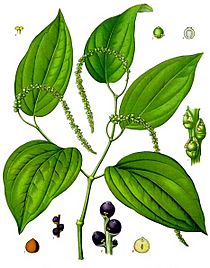 |
|
| Pepper plant with immature peppercorns | |
| Scientific classification | |
| Kingdom: | |
| Division: | |
| Class: | |
| Order: | |
| Family: | |
| Genus: | |
| Species: |
P. nigrum
|
| Binomial name | |
| Piper nigrum |
|
Black pepper is a plant that grows in warm, tropical places, especially in India. It's a perennial vine, meaning it lives for many years and climbs like a plant. People grow it for its fruit, which is called a peppercorn. This peppercorn is used as a spice or condiment to make food taste hot and flavorful.
There are different plants called Pepper, all belonging to the Piper plant family. Since the 16th century, the word pepper has also been used for chili peppers, which come from a completely different plant.
Contents
What is Black Pepper?
Pepper is one of the most common spices used all over the world. It's very popular in European cooking and has been traded for a very long time. Often, peppercorns are ground into a powder. This powder is then used to add a hot taste to food.
Pepper as a Medicine (Long Ago)
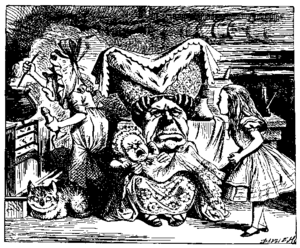
Like many spices from the East, pepper was used as both a seasoning and a medicine in the past. In ancient Indian medicine systems like Ayurveda, people believed black peppercorns could help with many health issues. For example, old texts from the 5th century suggested pepper for things like constipation, diarrhea, earache, and even toothaches.
Some old sources also said pepper was good for eye problems. They would make special ointments with pepper to put directly on the eye. However, today, there's no proof that these old treatments actually work. Putting pepper directly on your eye would be very uncomfortable and could even hurt it!
For a long time, people thought pepper made you sneeze. This idea is still around today. Some say a substance in pepper called piperine tickles your nostrils, causing a sneeze. Others think it's just the fine dust from ground pepper. Scientists haven't done many studies to find out for sure.
Pepper contains small amounts of certain chemicals. One of these is called safrole, which in large amounts might not be good for you.
Different Kinds of Peppercorns
There are several types of peppercorns, each made differently from the same pepper plant.
How Black Pepper is Made
Black pepper comes from the green, unripe fruits of the pepper plant. These fruits are briefly cooked in hot water. This helps clean them and gets them ready for drying. The heat helps the pepper turn dark. Then, the fruits are dried in the sun or by machines for several days. As they dry, the pepper around the seed shrinks and turns into a thin, wrinkled black layer. Once dried, it's called a black peppercorn.
Sometimes, on special farms, the berries are separated from their stems by hand. Then they are sun-dried without being boiled first. From dried peppercorns, people can also get pepper spirit and oil. These are used in some medicines and beauty products.
-
Ground black pepper and a plastic pepper shaker
How White Pepper is Made
White pepper is just the seed of the pepper plant. The dark outer skin of the fruit is removed. This is usually done by soaking the fully ripe red pepper berries in water for about a week. During this time, the fruit's flesh softens and breaks down. Then, the remaining fruit is rubbed off, and the clean seed is dried.
Ground white pepper is used in Chinese and Thai cooking. It's also used in dishes like salads or mashed potatoes where black specks would stand out. White pepper tastes a bit different from black pepper because it's missing some parts of the outer layer.
What is Green Pepper?
Green pepper is also made from unripe pepper fruits, just like black pepper. But green peppercorns are treated in a special way to keep their green color. This can be done by using certain chemicals, canning them, or freeze-drying. Pickled green peppercorns are unripe fruits kept in salty water or vinegar. Fresh green pepper fruits are not common in Western countries. But they are used in some Asian cuisines, especially in Thai cuisine. They have a spicy, fresh taste and a bright smell. They spoil quickly if not dried or preserved.
Wild Pepper Plants
Wild pepper grows in the Western Ghats area of India. Long ago, these forests had many wild pepper vines. But because of deforestation (cutting down trees), wild pepper now grows in smaller forest areas. The wild pepper source has become less important as people have improved how they grow pepper on farms.
Orange and Red Pepper
Orange or red pepper usually means ripe red pepper fruits. These are preserved in salty water or vinegar. Ripe red peppercorns can also be dried using methods that keep their color, similar to how green pepper is made.
Pink Pepper and Other "Peppers"
"Pink peppercorns" are actually the fruits of a different plant family. They come from the Peruvian pepper tree or the Brazilian peppertree. These trees are related to cashews. So, if you have a tree nut allergy, pink peppercorns might cause an allergic reaction.
Other plants are also used as pepper substitutes in different parts of the world. For example, in Chile and Argentina, the bark of a tree called Drimys winteri is used. In New Zealand, the seeds of Kawakawa (a relative of black pepper) are sometimes used.
How the Pepper Plant Grows
The pepper plant is a perennial woody vine. It can grow up to 4 meters (about 13 feet) tall. It climbs on trees, poles, or special frames. The plant spreads out, and its stems can grow roots easily if they touch the ground. Its leaves are about 5 to 10 cm (2 to 4 inches) long.
Small flowers grow on hanging spikes. These spikes are about 4 to 8 cm (1.5 to 3 inches) long. As the fruit grows, the spikes get longer, up to 7 to 15 cm (3 to 6 inches). The fruit of the black pepper plant is called a drupe. When it's dried, it becomes a peppercorn.
Pepper plants grow best in soil that is moist and drains well. They like soil rich in organic matter. They don't grow well in very high places. Farmers grow new plants from cuttings, which are small pieces of the plant. These cuttings are tied to nearby trees or climbing frames. Farmers clear away other plants, leaving enough trees for shade and good air flow. The roots are covered with leaves and fertilizer. The shoots are trimmed twice a year.
Young plants need watering every other day during the dry season for the first three years. The plants start to produce fruit in their fourth or fifth year. They usually keep producing fruit for about seven years.
One stem can have 20 to 30 fruiting spikes. Farmers start harvesting when one or two fruits at the bottom of the spikes begin to turn red. They pick them before the fruit is fully ripe and still hard. If the fruit ripens completely, it loses its spicy taste and falls off. The spikes are collected and dried in the sun. Then, the peppercorns are removed from the spikes.
Black pepper originally comes from Southeast Asia or South Asia. It is closely related to other Asian pepper species.
Where Pepper is Grown and Traded
| Top black pepper producers in 2013
(thousands of tonnes) |
||
|---|---|---|
| Country | Production | |
| 163 | ||
| 89 | ||
| 53 | ||
| 42 | ||
| 31 | ||
|
|
473 | |
In 2013, Vietnam was the biggest producer and exporter of black peppercorns in the world. It produced 163,000 tonnes, which was 34% of the total world production of 473,000 tonnes. Other big producers include Indonesia (19%), India (11%), and Brazil (9%). How much pepper is produced each year can change depending on how farms are managed, diseases, and the weather. Vietnam sells almost all its pepper to other countries.
Peppercorns are one of the most traded spices globally. They make up 20% of all spice imports.
The History of Pepper
Pepper comes from South Asia and Southeast Asia. It has been used in Indian cooking since at least 2000 BCE. While pepper grew in southern Thailand and Malaysia, its most important source was India. This was especially true for the Malabar Coast, which is now the state of Kerala.
Peppercorns were a very valuable item to trade. They were often called "black gold." People even used them as a form of commodity money (like a type of payment). This history is why we still have the term "peppercorn rent" today. It means a very small payment made for something that is actually given for free.
Before the 16th century, pepper was grown in places like Java, Sunda, Sumatra, Madagascar, and Malaysia. These areas mainly traded pepper with China or used it locally. Ports in the Malabar area of India were also important stops for trading other spices from further east. After the British took control in India, almost all the black pepper in Europe, the Middle East, and North Africa came from the Malabar region.
Pepper in Ancient Times
Black peppercorns were found in the nostrils of Ramesses II, an ancient Egyptian pharaoh. They were placed there as part of his mummification (preserving the body) when he died in 1213 BCE. We don't know much else about how pepper was used in ancient Egypt. We also don't know how it traveled from South Asia to the Nile River.
Pepper was known in Greece as early as the 4th century BCE. But it was probably rare and expensive, only for the very rich.
By the time of the early Roman Empire, especially after Rome took over Egypt in 30 BCE, ships regularly sailed across the Arabian Sea directly to southern India's Malabar Coast. This trade route across the Indian Ocean is described in an old book called Periplus of the Erythraean Sea. A Roman geographer named Strabo said that the Roman Empire sent about 120 ships each year. These ships would travel for a year to China, Southeast Asia, and India. They planned their trips to use the strong monsoon winds.
When returning from India, the ships sailed up the Red Sea. From there, the pepper was carried over land or through a canal to the Nile River. Then, it was put on barges to Alexandria and shipped to Italy and Rome. This trade route was used for about 1,500 years for the pepper trade to Europe.
Because ships sailed directly to the Malabar coast, black pepper traveled a shorter distance than long pepper. This made black pepper cheaper. Pliny the Elder wrote in his book Natural History around 77 CE about the prices in Rome. He complained that "there is no year in which India does not drain the Roman Empire of fifty million sesterces" (a type of Roman money). He also wondered why pepper was so popular:
It is quite surprising that the use of pepper has come so much into fashion... pepper has nothing in it that can plead as a recommendation... its only desirable quality being a certain pungency; and yet it is for this that we import it all the way from India! Who was the first to make trial of it as an article of food? (N.H. 12.14)
Black pepper was a well-known, though expensive, seasoning in the Roman Empire. A 3rd-century cookbook called De re coquinaria used pepper in most of its recipes. Historian Edward Gibbon wrote that pepper was "a favorite ingredient of the most expensive Roman cookery."
Pepper in Europe After Rome Fell
Pepper was so valuable that it was often used as collateral (something you offer as a promise to pay back a loan) or even as money. In Dutch, "pepper expensive" (peperduur) means something is very expensive.
When Rome fell, others took over the spice trade. First, the Persians and then the Arabs controlled the middle parts of the trade. By the end of the Early Middle Ages, the spice trade was mostly controlled by Islamic groups. Once the spices reached the Mediterranean Sea, Italian cities like Venice and Genoa mostly controlled the trade. These city-states became rich largely because of the spice trade.
A riddle from the 7th century by Saint Aldhelm, an English bishop, shows how important black pepper was in England:
I am black on the outside, clad in a wrinkled cover,
Yet within I bear a burning marrow.
I season delicacies, the banquets of kings, and the luxuries of the table,
Both the sauces and the tenderized meats of the kitchen.
But you will find in me no quality of any worth,
Unless your bowels have been rattled by my gleaming marrow.
Many people used to believe that during the Middle Ages, pepper was used to hide the taste of meat that had started to go bad. But there's no proof of this. Historians think it's unlikely because pepper was a luxury item back then. Only rich people could afford it, and they would have had fresh meat. Also, people knew that eating spoiled food would make them sick.
People also thought pepper was widely used to preserve food. It's true that piperine, the chemical that makes pepper spicy, has some properties that can stop tiny germs from growing. But the amount of pepper used in cooking wouldn't be enough to preserve food well. Salt was much better for preserving food, and salt-cured meat was common, especially in winter. However, pepper and other spices definitely made long-preserved meats taste better.

The very high price of pepper in the Middle Ages, and Italy's control over the trade, made the Portuguese look for a sea route to India. In 1498, Vasco da Gama was the first person to reach India by sailing around Africa. When Arabs in Calicut asked why they came, his representative said, "we seek Christians and spices." Even though this first trip wasn't a huge success, the Portuguese quickly returned with more ships. They eventually gained much more control of trade in the Arabian Sea. A treaty in 1494 gave Portugal special rights to the half of the world where black pepper came from.
But the Portuguese couldn't keep control of the spice trade all by themselves. Old Arab and Venetian trade networks still brought in huge amounts of spices. Pepper continued to flow through Alexandria and Italy, as well as around Africa. In the 17th century, the Portuguese lost almost all their valuable trade in the Indian Ocean to the Dutch and the English. These countries took advantage of Spain ruling Portugal (1580–1640) and took over most Portuguese areas in the region. The pepper ports in Malabar started trading more with the Dutch between 1661 and 1663.
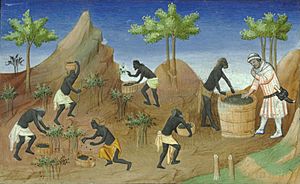
As more pepper came into Europe, its price went down. Pepper, which was once only for the rich, started to become an everyday spice for more average people. Today, pepper makes up one-fifth of all the spice trade in the world.
Pepper in China
It's possible that black pepper was known in China in the 2nd century BCE. This comes from old stories about an explorer named Tang Meng. He was sent by Emperor Wu to what is now southwest China. Tang Meng supposedly found something called jujiang or "sauce-betel." He was told it came from the markets of Shu, an area in what is now the Sichuan province. Most historians think "sauce-betel" was a sauce made from betel leaves. But some argue it might have been pepper, either long pepper or black pepper.
In the 3rd century CE, black pepper definitely appeared in Chinese writings. It was called hujiao or "foreign pepper." It didn't seem to be widely known then. It wasn't even in a 4th-century book that described many spices from outside China. However, by the 12th century, black pepper became very popular in the cooking of rich and powerful people. Sometimes, it even replaced China's own Sichuan pepper.
Marco Polo wrote about how popular pepper was in 13th-century China. He said that a customs officer told him that the city of Kinsay (Hangzhou) used about 43 loads of pepper every day. Each load was about 223 pounds. Marco Polo's information about China isn't always perfect. But if this estimate of 10,000 pounds (4,500 kg) a day for one city is even close to true, China's pepper imports might have been much larger than Europe's.
In the early 15th century, Admiral Zheng He and his ships returned from their voyages with so much black pepper. This made the once-expensive luxury a common item in China.
Pepper's Special Qualities

Like many spices from the East, pepper was used as both a seasoning and a folk medicine in the past. People believed black pepper could help with several illnesses, such as constipation, insomnia, and toothaches. Some old writings even suggested using pepper to treat eye problems. However, there is no modern medical proof that these treatments work.
Pepper is known to make people sneeze. Some sources say that piperine, a substance in black pepper, irritates the nose, causing the sneeze. Not many scientific studies have been done to confirm this.
Scientists are studying piperine to see if it can help the body absorb other good things. These include selenium, vitamin B12, and beta-carotene. In old Buddhist texts, pepper is mentioned as one of the few medicines monks were allowed to carry.
Pepper contains natural chemicals called phytochemicals. These include amides and piperidines. It also has tiny amounts of safrole, which in large amounts might not be good for you.
What's in Pepper?
One tablespoon (about 6 grams) of ground black pepper has some vitamin K (13% of what you need daily). It also has some iron (10% of daily need) and manganese (18% of daily need). It has small amounts of other important nutrients, protein, and fiber.
The Taste of Pepper
Pepper gets its spicy heat mostly from a chemical called piperine. This comes from both the outer fruit and the seed. Black pepper has between 4.6% and 9.7% piperine. White pepper has a little more. Pure piperine is about one hundred times less spicy than the capsaicin found in chili peppers.
The outer layer of the fruit, which is left on black pepper, also has chemicals called terpenes. These give pepper its citrusy, woody, and flowery smells. These smells are mostly missing in white pepper because its outer layer is removed. White pepper can sometimes get different smells (like a musty smell) from its longer soaking process.
Pepper loses its taste and smell when exposed to air. So, keeping it in an airtight container helps it stay spicy longer. Light can also make pepper lose its flavor. This is because light can change piperine into a nearly tasteless form. Once pepper is ground, its smells can disappear quickly. That's why most cooks suggest grinding whole peppercorns right before you use them. Handheld pepper mills or grinders are used for this. These grind or crush whole peppercorns. Spice mills have been in European kitchens since the 14th century. But using a mortar and pestle (a bowl and crushing tool) to crush pepper has also been popular for centuries.
Images for kids
-
Dried red Kampot peppercorns
See also
 In Spanish: Pimienta negra o Pimienta común para niños
In Spanish: Pimienta negra o Pimienta común para niños


